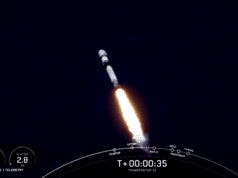
Small Satellite Launches – Independent, Flexible and Cost-effective
Until now, small satellites have tended to be carried into space aboard large rockets, if there is enough room for them. The primary aim of these flights is to place large satellites in a specific orbit. Small satellites take second place as far as timing and target orbit is concerned.
For this reason, 14 European research institutions and companies are working on designing an economical rocket launcher within the SMILE project. This should enable small satellites weighing up to 70 kilograms to be carried to near-Earth orbits.
3D Printing as a success factor
The rocket engine, developed by DLR scientists specifically for this application, consists of two central components – the metal injector head and the ceramic combustion chamber. Belgian project partner 3D Systems manufactured the prototype injector out of a nickel-chromium alloy using metal 3D printing. 3D printing is an additive process. Digital design data is used to build up or rather print the desired structure in layers by depositing material.
“Thanks to this relatively new manufacturing technology, we need significantly fewer parts and process steps, which speeds up the manufacturing process for the injector and reduces production costs. At the same time, we have been able to significantly reduce the mass of the components, which is always a very important factor in aerospace applications,” said Markus Kuhn, responsible for the project at the DLR Institute of Structures and Design in Stuttgart.
Combustion Chamber made of high-performance Ceramics
The researchers used a special high-performance material for the combustion chamber – a carbon fiber-reinforced ceramic that consists mainly of silicon carbide and was developed primarily at the DLR Institute in Stuttgart. It is particularly well-suited for high-temperature applications and reliably withstands even extreme temperature changes.
First Tests Passed
In hot firing tests in September 2018, the team led by DLR researcher Markus Kuhn subjected the rocket engine to an initial test run. It successfully completed a total of 18 tests at the high-pressure test bench of Spanish project partner PLD Space, with a firing time of up to 45 seconds, thereby showing very high combustion efficiency of over 90 percent.




